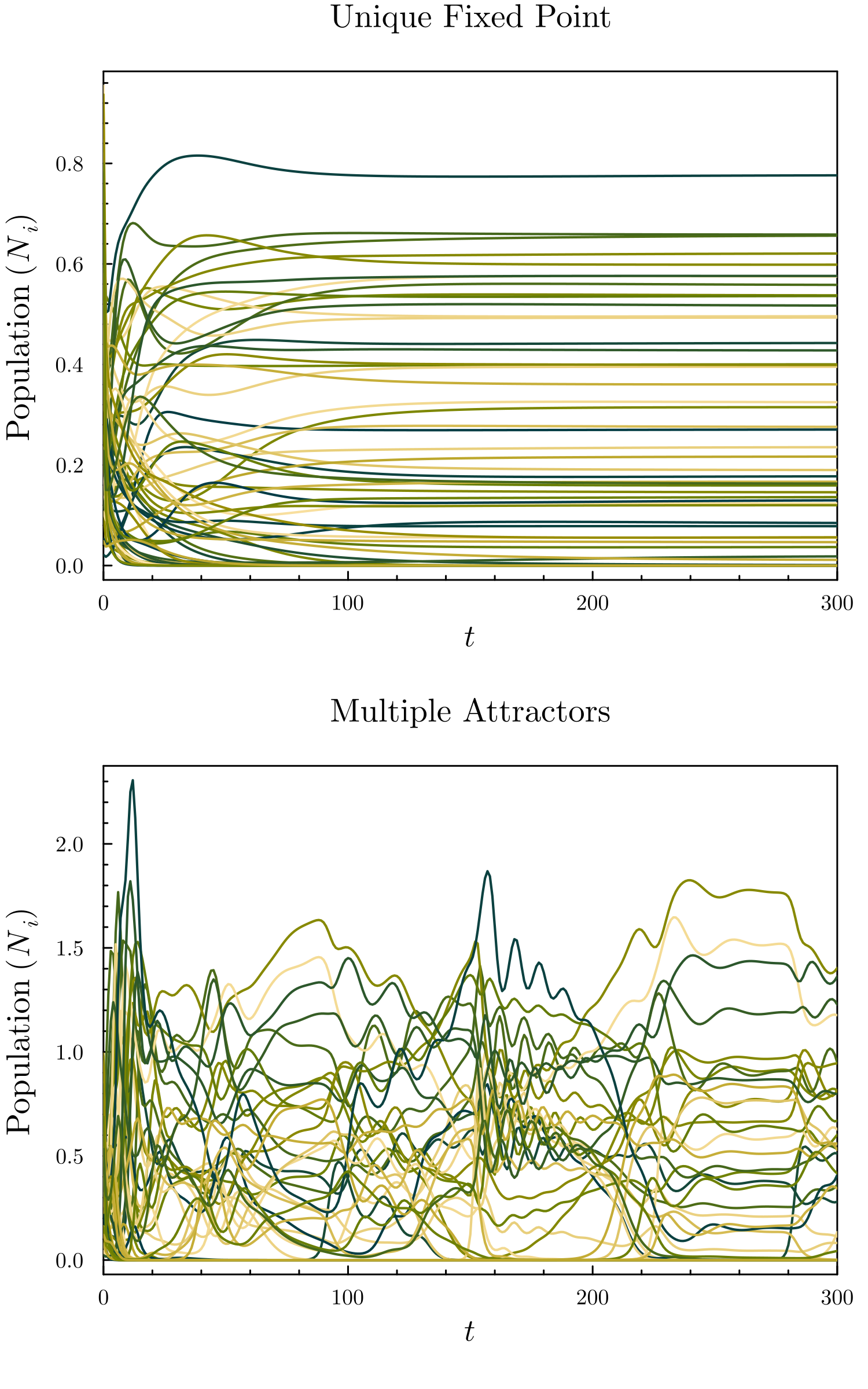|
Random Generalized Lotka–Volterra Model
The random generalized Lotka–Volterra model (rGLV) is an ecological model and Random dynamical system, random set of coupled ordinary differential equations where the parameters of the generalized Lotka–Volterra equation are sampled from a probability distribution, analogously to quenched disorder. The rGLV models dynamics of a community of species in which each species' abundance grows towards a carrying capacity but is depleted due to Competition (biology), competition from the presence of other species. It is often analyzed in the Thermodynamic limit, many-species limit using tools from statistical physics, in particular from spin glass theory. The rGLV has been used as a tool to analyze Emergence, emergent macroscopic behavior in microbial communities with dense, strong interspecies interactions. The model has served as a context for theoretical investigations studying Diversity (ecology), diversity-Stability (ecology), stability relations in community ecology and proper ... [...More Info...] [...Related Items...] OR: [Wikipedia] [Google] [Baidu] |
Random Matrix
In probability theory and mathematical physics, a random matrix is a matrix-valued random variable—that is, a matrix in which some or all of its entries are sampled randomly from a probability distribution. Random matrix theory (RMT) is the study of properties of random matrices, often as they become large. RMT provides techniques like mean-field theory, diagrammatic methods, the cavity method, or the replica method to compute quantities like traces, spectral densities, or scalar products between eigenvectors. Many physical phenomena, such as the spectrum of nuclei of heavy atoms, the thermal conductivity of a lattice, or the emergence of quantum chaos, can be modeled mathematically as problems concerning large, random matrices. Applications Physics In nuclear physics, random matrices were introduced by Eugene Wigner to model the nuclei of heavy atoms. Wigner postulated that the spacings between the lines in the spectrum of a heavy atom nucleus should resemble the ... [...More Info...] [...Related Items...] OR: [Wikipedia] [Google] [Baidu] |
Invasibility
Alien species, or species that are not native, invade habitats and alter ecosystems around the world. Invasive species are only considered invasive if they are able to survive and sustain themselves in their new environment. A habitat and the environment around it has natural flaws that make them vulnerable to invasive species. The level of vulnerability of a habitat to invasions from outside species is defined as its invasibility. One must be careful not to get this confused with invasiveness, which relates to the species itself and its ability to invade an ecosystem.Alpert, P., Bone, E., & Holzapfel, C. (2000). Invasiveness, invasibility and the role of environmental stress in the spread of non-native plants. ''Perspectives in Plant Ecology, Evolution and Systematics,'' ''3''(1), 52-66. doi:10.1078/1433-8319-00004 There are many factors, abiotic and biotic, that can raise or lower a habitat's invasibility, such as stress, disturbance, nutrient levels, climate, and pre-existin ... [...More Info...] [...Related Items...] OR: [Wikipedia] [Google] [Baidu] |
Standard Normal Random Variable
In probability theory and statistics, a normal distribution or Gaussian distribution is a type of continuous probability distribution for a real-valued random variable. The general form of its probability density function is f(x) = \frac e^\,. The parameter is the mean or expectation of the distribution (and also its median and mode), while the parameter \sigma^2 is the variance. The standard deviation of the distribution is (sigma). A random variable with a Gaussian distribution is said to be normally distributed, and is called a normal deviate. Normal distributions are important in statistics and are often used in the natural and social sciences to represent real-valued random variables whose distributions are not known. Their importance is partly due to the central limit theorem. It states that, under some conditions, the average of many samples (observations) of a random variable with finite mean and variance is itself a random variable—whose distribution converge ... [...More Info...] [...Related Items...] OR: [Wikipedia] [Google] [Baidu] |

